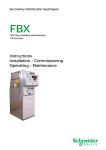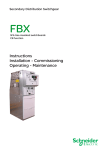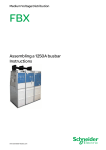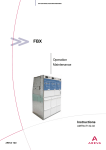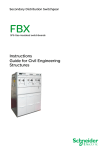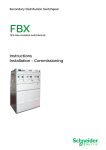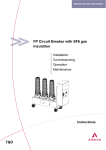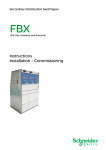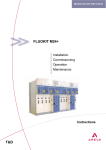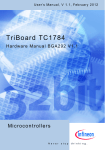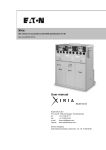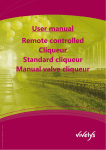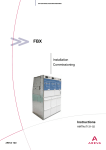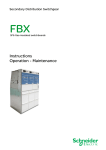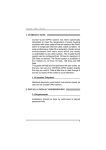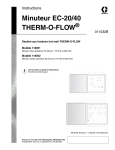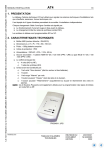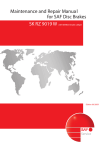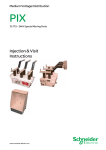Download FBX - CB Function
Transcript
SF6 GAS-INSULATED SWITCHBOARDS FBX - CB Function Installation Commissioning Operation Maintenance Instructions AMTNoT170-02 AREVA T&D Table of Contents 1 AREVA at your service . . . . . . . . . . . . . . . . . . . . . . . . . . . . . . . . . . . . . . . . . . . . . . . . . . . 1 1.1 1.2 Our Service Unit: our specialists, and suitably adapted services... . . . . . . . . . . . . . . . . . . . . . . . . . . . . AREVA T&D Technical Institute: together, let us develop our skills etc. . . . . . . . . . . . . . . . . . . . . . . . . 1 1 2 With regards to this User Manual . . . . . . . . . . . . . . . . . . . . . . . . . . . . . . . . . . . . . . . . . . 2 2.1 2.2 2.3 2.4 2.5 2.6 2.7 Responsibilities . . . . . . . . . . . . . . . . . . . . . . . . . . . . . . . . . . . . . . . . . . . . . . . . . . . . . . . . . . . . . . . . . . . . . . . . Reminder concerning normal service conditions (in accordance with the IEC62271-1 standard) . . . * Permissible ambient temperature . . . . . . . . . . . . . . . . . . . . . . . . . . . . . . . . . . . . . . . . . . . . . . . . . . . . . . . * Installation altitude . . . . . . . . . . . . . . . . . . . . . . . . . . . . . . . . . . . . . . . . . . . . . . . . . . . . . . . . . . . . . . . . . . . . * Atmospheric pollution . . . . . . . . . . . . . . . . . . . . . . . . . . . . . . . . . . . . . . . . . . . . . . . . . . . . . . . . . . . . . . . . . * Permissible atmospheric humidity level . . . . . . . . . . . . . . . . . . . . . . . . . . . . . . . . . . . . . . . . . . . . . . . . . . Particular instructions for operations and interventions on energized equipment . . . . . . . . . . . . . . . . Other technical notices to be consulted . . . . . . . . . . . . . . . . . . . . . . . . . . . . . . . . . . . . . . . . . . . . . . . . . . . Tools and products (not supplied) required for the operations described in this user manual . . . . . . Symbols & conventions . . . . . . . . . . . . . . . . . . . . . . . . . . . . . . . . . . . . . . . . . . . . . . . . . . . . . . . . . . . . . . . . . Tightening torque values [Nm] for standard assemblies (nut + bolt) . . . . . . . . . . . . . . . . . . . . . . . . . . . 2 2 2 2 2 2 3 3 3 3 3 3 Presentation of he 630 A CB Functional Unit . . . . . . . . . . . . . . . . . . . . . . . . . . . . . . . . 4 3.1 Presentation of the CB Functional Unit's mimic diagram . . . . . . . . . . . . . . . . . . . . . . . . . . . . . . . . . . . . . 4 4 Connection of the HV cables . . . . . . . . . . . . . . . . . . . . . . . . . . . . . . . . . . . . . . . . . . . . . . 5 4.1 4.2 4.3 Standard equipment for the FBX - up to 24 kV . . . . . . . . . . . . . . . . . . . . . . . . . . . . . . . . . . . . . . . . . . . . . Fitting of a metering torus on one or two cables per phase (optional) . . . . . . . . . . . . . . . . . . . . . . . . . . Example of cable connections with a single torus per phase . . . . . . . . . . . . . . . . . . . . . . . . . . . . . . . . . 5 5 5 5 Use of the CB function . . . . . . . . . . . . . . . . . . . . . . . . . . . . . . . . . . . . . . . . . . . . . . . . . . . 7 5.1 5.2 5.3 5.4 5.5 5.6 5.7 Opening the earthing switch . . . . . . . . . . . . . . . . . . . . . . . . . . . . . . . . . . . . . . . . . . . . . . . . . . . . . . . . . . . . . Closing the earthing switch . . . . . . . . . . . . . . . . . . . . . . . . . . . . . . . . . . . . . . . . . . . . . . . . . . . . . . . . . . . . . . Closing the line isolating switch [earthing switch open - circuit breaker tripped] . . . . . . . . . . . . . . . . . Opening the line isolating switch [circuit breaker tripped] . . . . . . . . . . . . . . . . . . . . . . . . . . . . . . . . . . . . Closing the circuit breaker [Line Isolator closed] . . . . . . . . . . . . . . . . . . . . . . . . . . . . . . . . . . . . . . . . . . . . Re-arming the CB closing spring [CB closed] . . . . . . . . . . . . . . . . . . . . . . . . . . . . . . . . . . . . . . . . . . . . . . Opening the circuit breaker [Line Isolator closed] . . . . . . . . . . . . . . . . . . . . . . . . . . . . . . . . . . . . . . . . . . . 7 7 8 8 8 9 10 6 CB Function diagram . . . . . . . . . . . . . . . . . . . . . . . . . . . . . . . . . . . . . . . . . . . . . . . . . . . . 11 6.1 "Metering - Protection - Signalling" section . . . . . . . . . . . . . . . . . . . . . . . . . . . . . . . . . . . . . . . . . . . . . . . . 'Control' section . . . . . . . . . . . . . . . . . . . . . . . . . . . . . . . . . . . . . . . . . . . . . . . . . . . . . . . . . . . . . . . . . . . . . . . 11 12 i 7 WIC1 or DPX-1 protection relays (option) . . . . . . . . . . . . . . . . . . . . . . . . . . . . . . . . . . . 13 7.1 7.2 7.3 Configuring the protection relays. . . . . . . . . . . . . . . . . . . . . . . . . . . . . . . . . . . . . . . . . . . . . . . . . . . . . . . . . WIC1 & DPX-1 protection relays . . . . . . . . . . . . . . . . . . . . . . . . . . . . . . . . . . . . . . . . . . . . . . . . . . . . . . . . . WI1-SZ5 fault indicator . . . . . . . . . . . . . . . . . . . . . . . . . . . . . . . . . . . . . . . . . . . . . . . . . . . . . . . . . . . . . . . . . 13 13 13 8 Maintenance . . . . . . . . . . . . . . . . . . . . . . . . . . . . . . . . . . . . . . . . . . . . . . . . . . . . . . . . . . . . 14 8.1 8.2 8.3 8.4 8.5 8.6 8.7 8.8 8.9 8.10 8.11 8.12 8.13 8.14 Levels of maintenance . . . . . . . . . . . . . . . . . . . . . . . . . . . . . . . . . . . . . . . . . . . . . . . . . . . . . . . . . . . . . . . . . . General Safety Instructions . . . . . . . . . . . . . . . . . . . . . . . . . . . . . . . . . . . . . . . . . . . . . . . . . . . . . . . . . . . . . Maintenance of the mechanical control mechanism . . . . . . . . . . . . . . . . . . . . . . . . . . . . . . . . . . . . . . . . . Corrective maintenance . . . . . . . . . . . . . . . . . . . . . . . . . . . . . . . . . . . . . . . . . . . . . . . . . . . . . . . . . . . . . . . . Removal of the protective cover for all maintenance operations . . . . . . . . . . . . . . . . . . . . . . . . . . . . . . Location of LV components . . . . . . . . . . . . . . . . . . . . . . . . . . . . . . . . . . . . . . . . . . . . . . . . . . . . . . . . . . . . . To replace the motor (1) [See § 8.6) . . . . . . . . . . . . . . . . . . . . . . . . . . . . . . . . . . . . . . . . . . . . . . . . . . . . . . Replacement of the tripping coil (2) [See Section 8.6] . . . . . . . . . . . . . . . . . . . . . . . . . . . . . . . . . . . . . . . Replacing an under/overvoltage tripping coil (3 or 4) [See Section 8.6] . . . . . . . . . . . . . . . . . . . . . . . . To replace the striker (5) [See section 8.6] . . . . . . . . . . . . . . . . . . . . . . . . . . . . . . . . . . . . . . . . . . . . . . . . Replacing the undervoltage tripping coil (6) control board [See section 8.6] . . . . . . . . . . . . . . . . . . . . Replacing the diode bridge (7) [See section 8.6] . . . . . . . . . . . . . . . . . . . . . . . . . . . . . . . . . . . . . . . . . . . Replacing the motor control board (8) [See Section 8.6] . . . . . . . . . . . . . . . . . . . . . . . . . . . . . . . . . . . . . Replacing a motor re-arming contact (9) [mechanical control tripped and un-armed] . . . . . . . . . . . . Adjust the motor arming lock before the contacts. . . . . . . . . . . . . . . . . . . . . . . . . . . . . . . . . . . . . . . . . . . Adjusting the electrical arming contacts. . . . . . . . . . . . . . . . . . . . . . . . . . . . . . . . . . . . . . . . . . . . . . . . . . . 14 14 14 14 15 15 16 17 18 19 19 20 20 21 21 21 9 Spare parts for the circuit breaker . . . . . . . . . . . . . . . . . . . . . . . . . . . . . . . . . . . . . . . . . 22 9.1 9.2 9.3 Intervention levels . . . . . . . . . . . . . . . . . . . . . . . . . . . . . . . . . . . . . . . . . . . . . . . . . . . . . . . . . . . . . . . . . . . . . The spare part . . . . . . . . . . . . . . . . . . . . . . . . . . . . . . . . . . . . . . . . . . . . . . . . . . . . . . . . . . . . . . . . . . . . . . . . Identification and storage of the parts . . . . . . . . . . . . . . . . . . . . . . . . . . . . . . . . . . . . . . . . . . . . . . . . . . . . . 22 22 22 10 Notes . . . . . . . . . . . . . . . . . . . . . . . . . . . . . . . . . . . . . . . . . . . . . . . . . . . . . . . . . . . . . . . . . . 23 ii 1 AREVA at your service Operations and maintenance may only be carried out by personnel who have received suitable autho risation for the operations and manœuvres they are responsible for performing. 1.1 F F F F F F F F If this is not the case, please refer to our Service Unit or Training Centre. All locking-out operations must be performed according to the "Gene Our Service Unit: our specialists, and suitably adapted services... Guarantee extension contracts in relation to the selling of new equipment, Supervision of HVA switchgear installations, Technical advice, diagnoses of the facilities, expertise, Maintenance contracts adapted to operational constraints, Systematic or conditional preventive maintenance, Corrective maintenance in case of partial or complete failure, Supply of spare parts, Overhauling of equipment and requalification of installations in order to benefit from new technologies and extend the life of your switchgear by limited investments. 1.2 ral Safety Instructions booklet for Electrical Applications" UTE C 18 510 (or its equivalent outside FRANCE). Contact the AREVA Service Unit for diagnoses and advice: Working hours ' 7 or 33 (0)3 85 29 35 00 33 (0)3 85 29 36 30 33 (0)3 85 29 36 43 AREVA T&D Technical Institute: together, let us develop our skills etc. We can place at your disposal all of our trainers’ expertise, our teams’ pedagogical experience and the wealth of our equipment, to help you face the challenge of encouraging the personal development of each individual through the optimisation of their skills. From a few hours up to several weeks, AREVA T&D Technical Institute has the control over all of the teaching processes in order to meet the needs of each customer. F F F F Specific training, directly operational with practical work on real machines. Small groups to facilitate communication. A balance between theory and practice. Evaluation and management of the skills: measurement and optimisation of the trainees' knowledge. Faced with the direct and indirect training costs of the operational stoppages and shutdown, training is a real investment AREVA T&D Technical Institute Aix-les-Bains 1 rue Paul Doumer - BP 601 - F-73106 Aix-les-Bains Cedex ' 33 (0)4 79 34 76 70 7 33 (0)4 79 34 76 76 * [email protected] 1 2 With regards to this User Manual © - AREVA - 2010. AREVA, the AREVA logo and their figurative forms are AREVA registered tra 2.1 whether they be copyright or not, belong to their respective holders. dance with the indications given in this document, must be observed. - of any possible aggressive clima tic conditions (humidity, pollution, etc.) acting in the immediate envi ronment of the materials that are neither suitably adapted nor pro tected for these effects. This user manual does not list the locking-out procedures that must be applied. The interventions des cribed are carried out on de-energi zed equipment (in the course of being installed) or locked out (non operational). Responsibilities Our devices are quality controlled and tested at the factory in accor dance with the standards and the regulations currently in force. Apparatus efficiency and apparatus life depend on the compliance with the installation, commissioning and operation instructions described in this user manual. Non respect of these instructions is likely to invali date any guarantee. Local requirements especially about safety which are in accor 2.2 demarks. The other brand names mentioned within this document, AREVA declines any responsibility for the consequences: - due to the non respect of the recommendations in this manual which make reference to the inter national regulations in force, - due to the non respect of the instructions by the suppliers of cables and connection accessories during installation and fitting ope rations, Reminder concerning normal service conditions (in accordance with the IEC62271-1 standard) * Permissible ambient temperature The ambient air temperature should be comprised between - 5° C (on option 15 or -25°C) and + 40° C. The mean measured value for a 24 hour period must not exceed 35°C. * Installation altitude Items of HV equipment are defined in accordance with IEC Standards and can be used up to an altitude of 1000 m. Above this, you may have to take into account the reduced atmospheric pressure. For these specific cases, contact the AREVA Sales Department * Atmospheric pollution The ambient air must not contain any dust particles, fumes or smoke, corrosive or flammable gases, vapours or salts. * Permissible atmospheric humidity level The average atmospheric relative humidity level measured over a 24-hour period must not exceed 95%. The average water vapour pressure over a period of 24 hours must not exceed 22 mbar. The average atmospheric relative humidity value measured over a period of one month must not exceed 90 %. 2 The average water vapour pressure over a period of one month must not exceed 18 mbar. appropriate lay-out of the room or of the building (suitably adapted ventilation, air driers, heating etc.). Condensation may appear in case of any sharp variation in tempera ture, due to excessive ventilation, a high atmospheric humidity level or the presence of hot air. This condensation can be avoided by an Whenever the humidity level is higher than 95 %, we recommend that you take appropriate corrective measures. For any assistance or advice, contact the AREVA AfterSales department (See § 1.1). 2.3 Particular instructions for operations and interventions on energized equipment When commissioning and opera ting the equipment under normal conditions, the General safety instructions for electrical applica tions must be respected, (protec tive gloves, insulating stool, etc.), in addition to standard operating instructions. 2.4 All manipulations must be comple ted once started. The durations (for completing the operations mentioned) given in the maintenance tables are purely an indication and depend on on-site conditions. Other technical notices to be consulted For all operations relating to the installation and use of the switch board, see the manuals listed below. F F F 2.5 AMTNoT110-02 FBX AMTNoT131-02 FBX AMTNoT132-02 FBX Guide to Civil Engineering Work Installation - Commissioning Operation - Maintenance Tools and products (not supplied) required for the operations described in this user manual - Crowbar - Scissors - Open-ended spanners sizes 8, 10 and 13 - 2 x open-ended spanners - size 7 - Allen key - sizes 3, 4 and 5 mm - Ratchet handle + extension with socket sizes 8, 10, 13 and 16 mm - Torque wrench - Cutting pliers 2.6 Symbols & conventions 06 2.7 CAUTION! Remain vigilant! Precautions to be CAUTION taken in order to avoid accidents or injury - Code for a product recommended and marketed by AREVA 21 Nm - Tightening torque value Example: 21 Nm 10 - Mark corresponding to a key FORBIDDEN! Do not do it! Compliance with this indication is compulsory, non compliance with this stipulation may damage the equipment. INFORMATION - ADVICE Your attention is drawn to a specific point or operation Tightening torque values [Nm] for standard assemblies (nut + bolt) Diameter Plastic (PA 6.6) Steel Class < 8.8 Steel Class > 8.8 < 10.9 Threaded fasteners with grease A2-70 M6 0.8 4.3 8.8 6.6 M8 1.8 10.5 21.0 15.8 M 10 3.5 14.0 42.0 35.0 M 12 6.0 - 70.0 60.0 M 16 12.0 - 170.0 134.0 3 3 Presentation of the 630 A CB Functional Unit This manual only covers the 630 A CB Function. It is complementary to the General Manual AMTNoT131 (See Section 2.4). 3.1 The 630 A CB Functional Unit is fitted with a C150 mechanical control mechanism. Presentation of the CB Functional Unit's mimic diagram Extendable Extendable 12 13 10 9 11 8 7 1 5 2 6 14 3 4 0 - 1 - 2 - 3 - 4 - 5 - 6 - 7 - 8 - 9 - 10 - 11 - 12 - 13 - 14 4 Key Lever socket for the earthing switch Earthing switch position indicator Cable compartment cover latch Descriptive plate Disconnector position indicator Lever socket for the disconnector Interlock between disconnector and earthing switches Interlock between disconnnector and circuit breaker Circuit breaker position indicator Lever socket for the circuit breaker “Primed-released” indicator light showing position of the spring Push button for tripping Push button for closing Fault indicator (optional) 4 Connection of the HV cables 4.1 Standard equipment for the FBX - up to 24 kV For all installation and connection operations see the corresponding manual (See Section 2.4). 4.2 F F 4.3 F F Fitting of a metering torus on one or two cables per phase (optional) The fitting of the torus must be completed at the same time as the connections to the withdrawable plugs. The tightening of the fixings is completed after the plugs are connected. F Phase L2: The torus is fitted below the two others. F Installation of a torus, with 2 cables per phase. Example of cable connections with a single torus per phase Fit the rear crossmember torus mounting (with rear cradle) to hold the central torus in place. Screw in, but do not tighten, the 4 screws. F F F Pass the HVA cables through the opening in the cable run. Fit the toruses onto the cables, making sure they are the right way round. Put together the plug-in connectors. F Phases L1 and L3: Lift the torus to place it above the rear crossmember whilst attaching the socket to the crossmember. 5 F F F Phase L2: Lift the torus to place it in the rear cradle whilst attaching the socket to the crossmember. Position the front crossmember. Tighten the 2 screws on the front cradle. F F F Attach the front crossmember using 2 screws without tightening them. Attach all toruses (4 screws per unit). Attach the earthing wire using the front right hand side mounting screw. F F F F F F Remove the protective cover. Connect the secondary torus circuits as per the identification marks and diagrams. Complete connection by clamping the cables (See the corresponding manual Section 2.4). 6 F Refit the protective cover. F Refit the front cradle for the Phase L2 torus. The three toruses are shown in place, without the phase L1 and L3 cables. Pass the LV wiring through, as shown. Attach this wiring bundle in three places. Tighten all fixing bolts. 5 Use of the CB function 5.1 F F 5.2 Opening the earthing switch Check that the tag is fully lowered. Insert the appropriate lever (red end) into the earthing switch socket. F Grasp the lever with both hands. F F Lift the lever: the earthing switch is now in the open position. Remove the lever. Closing the earthing switch Before closing the earthing switch, ensure there is no voltage across the indicator units (see corresponding manual - § 2.4). F F Hold the locking tab open to the right. Insert the appropriate lever (red end) into the earthing switch socket. F Grasp the lever with both hands. F F Pull the lever down: the earthing switch is closed. Remove the lever. 7 5.3 Closing the line isolating switch [earthing switch open - circuit breaker tripped] Lift the locking tab. Insert the lever (black end) into the disconnector switch socket. F F 5.4 F 5.5 F Grasp the lever with both hands. F F Lift the lever: The line isolator is now closed. Remove the lever. Opening the line isolating switch [circuit breaker tripped] Lift the locking tab. Insert the lever (black end) into the disconnector switch socket. F F F Grasp the lever with both hands. F F Pull the lever down: The line isolator is now open. Remove the lever. Closing the circuit breaker [Line Isolator closed] Circuit breaker operating lever. F F 8 Circuit breaker open make sure that the tag is fully lowered. Introduce the lever into the re-arming spring's switch hub. F Turn the lever to the left to re-arm the CB closing spring (rotate through approx. 350°). Do not force the lever at the end of the operating! F 5.6 F The indicator will show that the spring is 'armed'. F Press the (green) 'I' button. F F Re-arming the CB closing spring [CB closed] The closing spring is 'unarmed'. F For motorised controls, the CB closing spring is re-armed as soon as the CB is closed. F F F The circuit breaker is now closed. The CB closing spring is 'unarmed'. Turn the lever to the left to re-arm the CB closing spring (rotate through approx. 350°). F For manual controls, you must manually re-arm the CB closing spring. Introduce the lever into the re-arming spring's switch hub. The indicator will show that the spring is 'armed' even though the CB is closed. 9 5.7 F Opening the circuit breaker [Line Isolator closed] Press the (red) 'O' button. 10 F The circuit breaker is now open. 6 CB Function diagram Key Q01: circuit breaker Q01-F11, Q01-F12: Trip Coils Q01-F13: Undervoltage tripping coil Q01-F14: Closure Coil Q01-F31: striker pin Q01-LS1 to LS3: spring position contacts Q01-S1: Circuit breaker position contact Q01-S52: Lever insertion locking contact Q01-S53, Q01-S54: Motor interlock contacts Q11: Disconnector Q11-S1: Disconnector position contact Q11-S51: Closing interlock contact -H1: 'Pressure' indictor contact -H301: 'Fault' indicator contact C1: Connector F1: Fuse M: Motor V01, V02: Bridge rectifiers X1, X3: Test terminal box X10, X12A: Connectors X14, X15, X16: Connectors Contacts for signalling a fault (option) Disconnector position contacts Contacts for signalling pressure (option) Circuit breaker position contacts Armed/Unarmed position contact (option) "Metering - Protection - Signalling" section Position Contacts for the earthing switch. 6.1 0 0 0 0 0 0 0 0 0 0 Protection Protection (Option depending on type of relay) The terminals of 'current' circuits are highlighted and protected by a DANGER label. Metering (option) 11 Optional Closing coil Tripping Coil 2nd tripping coil Not simultaneously Remove this jumper if a protection relay is fitted Motorization board 12 Anti-pumping system Striker** (option) Optional Motorization Undervoltage tripping coil (option) 'Control' section 7 WIC1 or DPX-1 protection relays (option) Configuring the protection relays. The relays are supplied preconfigured, with a default set ting of their maximum levels. White Green WIC1 & DPX-1 protection relays Red 7.2 To adjust the protection relays, see the manual sup plied with the switchboard. Black 7.1 Orange Violet F 7.3 F WIC1: Standard autonomous protection relay (without earthing fault). Optional: with earthing fault. F DPX-1: Autonomous protection relay with earthing fault detection and indicator light: - flashing green: OK, - fixed green: problem with the relay, - fixed red: detection of fault current. F Yellow Blue Indicator Brown WI1-SZ5: wiring connnectivity diagram. WI1-SZ5 fault indicator Indicator normal (no fault) F Indicator showing a fault (red) F Press the green button to delete the fault. 13 8 Maintenance 8.1 Levels of maintenance Definition Levels Operations recommended in the instructions manual "installation - operation - maintenance", carried out by suitably qualified personnel having received training allowing them to intervene whilst respecting the safety rules. 1 Complex operations, requiring specific expertise and the implementation of support equipment in accordance with AREVA's procedures. These are carried out by AREVA or by a specialised technician, trained by AREVA (see § 1.2) in the implementation of procedures, and who is equipped with specific equipment. 2 All preventive and corrective maintenance, all renovation and reconstruction work is carried out by AREVA. 8.2 General Safety Instructions Never separate the C150 control mechanism from the circuit breaker part. 8.3 3 Never remove the command control cover without having cut off the LV auxiliaries. Ensure that the springs have been released by carrying out a complete O-C-O cycle. Maintenance of the mechanical control mechanism Under normal installation and ser vice conditions, the CB630 circuit breaker requires no maintenance: - throughout the 25 years of its ser vice life, - as long as it has not reached the maximum number of operating cycles. By cycle we mean a closing then an opening operation. The internal electrical connec tions as well as the adjust ments to the control mechanism are carried out at the factory and cannot be modified. PREVENTIVE MAINTENANCE Frequency Recommended operations 3 years Levels 1 2 3 Inspection of the tightening of the threaded fasteners and presence of stop elements X - X X Carry out a few opening and closing operations of the circuit breaker with the manual (and electrical) controls to ensure its correct operation. X - X X Monitor the general appearance of the mechanical components and connections X - X X 8.4 Corrective maintenance CORRECTIVE MAINTENANCE Replacements or modifications Levels See chapter 1 2 3 Replacement of the motor (1) 8.7 - X X Replacement of the tripping coil (2) 8.8 - X X Replacement of an under/overvoltage tripping coil (3 and 4) 8.9 - X X Replacement of a fuse striker (5) 8.10 - X X Replacement of the undervoltage tripping coil (6) 8.11 - X X Replacement of a diode bridge (7) 8.12 - X X Replacing the motor electronic control card (8) 8.13 - X X Replacement of a motor reset contact (9) 8.14 - X X 14 8.5 Removal of the protective cover for all maintenance operations Cut off the LV auxiliaries’ power circuits, Maintenance operations absolutely must be carried out with the circuit breaker open and the control mechanism deac tivated. F F 8.6 Unscrew the 5 attachment screws holding the front plates (Allen key - 4mm). Remove the complete cover and twin front cover assembly. F F Remove the plate F Unscrew the 4 cover mount fixing screws (Allen key for hexagonal screws size 4). F Unscrew the 4 cover fixing screws (Allen key for hexagonal screws size 4). Pull off the cover mounts. Location of LV components 2 3 4 5 7 6 8 1 9 F Complete replacement of a C150 control mechanism can only be carried out by AREVA (See § 1.1). 0 - 1 2 3 4 - 5 - 6 - 7 - 8 - 9 Key Motor Closing Coil Tripping Coil on voltage release Tripping Coil on voltage release/application Striker Electronic control board for voltage release coil Diode bridge Electronic motor board Motor rearming contacts Location of LV elements 15 8.7 To replace the motor (1) [See § 8.6) Apply the General Safety Instructions for Electrical Applications and the particular rules for the network concerned for locking out procedures. F F Disconnect the LV cables from the motor. The motor is kept in place by its 3 fixing points. Tools required: - Cutting pliers - Allen keys for hexagonal screws size 5 + extension and ratchet wrench F Unscrew each of the the fixing screws (Allen key for hexagonal screws size 5). Parts required: - 1 motor of the same reference - 3 washers + 3 mounting bolts - 3 Rilsan cable ties Duration: 1 h 30 F Remove and extract the motor. 1 F F Present the new motor. Identify the drive pin. F Using the lever, turn the mechanism's shaft clockwise to align the slot with the pin. F F F F Make sure that the three mounting points are flat against the partition panel. Tighten the fixing bolts. 16 F F Reconnect the motor wires. Re-clamp the cables. Engage the motor with its centrin device (1) and use the 3 bolts an 3 new washers supplied. Insert the operating lever to align the centring device and motor drive shaft. 8.8 Replacement of the tripping coil (2) [See Section 8.6] Apply the General Safety Instructions for Electrical Applications and the particular rules for the network concerned for locking out procedures. F F Hold the coil in place. Unscrew and remove the 2 fixing bolts (Allen key of 3 mm). Tools required: - Cutting pliers - Allen key for hexagonal screw size 3 - 2 x open-ended spanners - size 7 F F Cut the fixing collars on the wiring. Disconnect the connector from the coil. Parts required: - 1 coil with the same reference - 2 pre-treated bolts and 2 washers - 3 Rilsan cable ties Duration: 1 h F Extract the coil from the front. D1 F Measure distance D1 on the removed coil. F F Measure the same distance D1 on the new coil. Tighten the nuts. F F Positioning the new coil. Insert and tighten the 2 new mounting bolts supplied. D2 F Make sure that the distance (D2) between the centre of the coil and the drive tab is equal to 4 mm. F F Reconnect the LV connector. Fix the cables in place using Rislan cable ties. 17 8.9 Replacing an under/overvoltage tripping coil (3 or 4) [See Section 8.6] Apply the General Safety Instructions for Electrical Applications and the particular rules for the network concerned for locking out procedures. Tools required: - Cutting pliers - Allen key for hexagonal screw size 3 - 2 x open-ended spanners - size 7 Parts required: - 1 coil with the same reference - 2 pre-treated bolts and 2 washers - 3 Rilsan cable ties Duration: 1 h Coil (4) may be either on voltage release/application. For an undervoltage tripping coil, first remove the coil board (See Section 8.11). F F Cut the fixing collars on the wiring. Disconnect the connector from the coil. F F Hold the coil in place. Unscrew and remove the 2 fixing bolts (Allen key of 3 mm). D1 F F Note which way round the coil goes. Remove this coil from the right hand side. F Measure distance D1 on the removed coil. F F Measure the same distance D1 on the new coil. Tighten the nuts. Top view 3 4 D3 F F Positioning the new coil. Insert and tighten the 2 new mounting bolts supplied. 18 F Make sure that the distance (D3) between the centre of the coil and the trip tab is equal to 3 mm F F Reconnect the LV connector. Fix the cables in place using Rislan cable ties. 8.10 To replace the striker (5) [See section 8.6] Apply the General Safety Instructions for Electrical Applications and the particular rules for the network concerned for locking out procedures. Tools required: - Cutting pliers - Allen key for hexagonals crew size 3 - 2 x open-ended spanners - size 8 Parts required: - 1 striker pin with the same reference - 2 pre-treated bolts and 2 washers - 3 Rilsan cable ties Duration: 1 h To change the striker (5), first remove the trip coil (4) (See section 8.9). F F F F Cut the fixing collars on the wiring. Disconnect the connector from the striker. Hold the striker in place. Unscrew and remove the 2 fixing bolts (Allen key of 3 mm). F Remove the striker from the right hand side. F F F F Position the new striker and press it against the bolt heads. Insert and tighten the 2 new mounting bolts supplied. Reconnect the LV connector. Fix the cables in place using Rislan cable ties. 8.11 Replacing the undervoltage tripping coil (6) control board [See section 8.6] Apply the General Safety Tools required: Instructions for Electrical - Flat headed screwdriver Applications and the particular rules - 8 mm spanner for the network concerned for locking out procedures. F Using a flat headed screwdriver, loosen the two connectors. F Unscrew the 2 fixing screws (8 mm spanner). Parts required: - 1 board of the same reference Duration: 0 h 30 F F Pull out the board. Attach and reconnect the new board in its place. 19 8.12 Replacing the diode bridge (7) [See section 8.6] Apply the General Safety Instructions for Electrical Applications and the particular rules for the network concerned for locking out procedures. F F F Tools required: - Allen key for hexagonal screw size 3 - Flat headed screwdriver Parts required: - 1 diode bridge of the same reference Duration: 0 h 30 Unscrew the central bolt holding the bridge in place. Replace the diode bridge Refit the new bridge in its place. 8.13 Replacing the motor control board (8) [See Section 8.6] Apply the General Safety Instructions for Electrical Applications and the particular rules for the network concerned for locking out procedures. F F The motor control board is lodged against the left hand upright in the C150 control compartment. Press the two pins on the front to free the board. 20 Tools required: - Allen key for hexagonal screw size 3 - Flat headed screwdriver F F Lightly push the board aside then pull forwards to free from its rear connector. Pull out the board from the bottom. Parts required: - 1 board of the same reference Duration: 1 h 00 F F F Disconnect the board. Replace the board with one of the same reference. Repeat the operations detailed above in reverse to refit the new board. 8.14 Replacing a motor re-arming contact (9) [mechanical control tripped and un-armed] F The motor re-arming contacts are located in the bottom right hand corner of the C150, behind the front panel. F Loosen then remove the two mounting bolts from the front. F Remove the contact block. F Replace the defective contact. F Refit the block without tightening the bolts. Adjust the motor arming lock before the contacts. F Loosen the 2 screws on the end of the lock slightly. F Turn this lock to align the arrow horizontally in the window. F Once this adjustment has been made, tighten the 2 screws. Adjusting the electrical arming contacts. F Turn the mount to bring the contact tabs into contact with the lock. F View of the inside of the mechanism: The tabs are pressing against the lock probe. F Tighten the 2 fixing screws. 21 9 Spare parts for the circuit breaker 9.1 Intervention levels For an explanation of the levels of maintenance, please refer to § 8.1. 9.2 The spare part Describes a part that is designed to replace a corresponding one with a view to re-establishing the original function. The replacement of these parts can only be carried out by a person who is suitably quali fied and trained for this operation. Exceptional replacement Describes the spare parts or assemblies whose foreseeable service life is at least equal to that of the equipment. Use: Spare parts or sub-assemblies kept in a safety stock. 9.3 1 2 3 Tripping coil (closing or tripping operations) - X X Undervoltage coil - X X Undervoltage coil control card - X X Striker - X X Diode bridge - X X Motor - X X Anti-pumping relay - X X Operation counter - X X Cirrcuit breaker auxiliary contact - X X Spring position microswitch - X X Microswitch (motor, undervoltage coil, locking) - X X Ring - X X Fitted C150 control - X X Identification and storage of the parts For all orders for spare parts, it is necessary to enclose the equipment characteristics form. 22 Levels Denomination The components should be stored away from dust, humidity and the sun. In order to facilitate their retrieval, they must be marked by the AREVA reference number. Certain components are fragile, they should preferably be stored in their original factory packaging. 10 Notes If you have any comments on the use of this document or on the use of the equipment and services that are described in it, please send us your remarks, suggestions and wishes to: AREVA Service Technique BP 84019 F-71040 Mâcon Cedex 9 - FRANCE Fax: 33 (0)3 85 29 36 36 23 AREVA T&D Boulevard de la Résistance BP84019 F-71040 Mâcon Cedex 9 - FRANCE Tel.: +33 (0)3 85 29 35 00 - Fax: +33 (0)3 85 29 36 36 AMTNoT170-02 00 (06/2010) E - AREVA - 2010. AREVA, the AREVA logo and any alternative version thereof are trademarks and service marks of AREVA. The other names mentioned, registered or not, are the property of their respective companies. - 389191982 RCS PARIS - Creation : AREVA Mâcon - Printed in France. Our policy is one of continuous development. Accordingly the design of our products may change at any time. Whilst every effort is made to produce up to date literature, this brochure should only be regarded as a guide and is intended for information purposes only. Its contents do not constitute an offer for sale or advise on the application of any product referred to in it. We cannot be held responsible for any reliance on any decisions taken on its contents without specific advice.




























